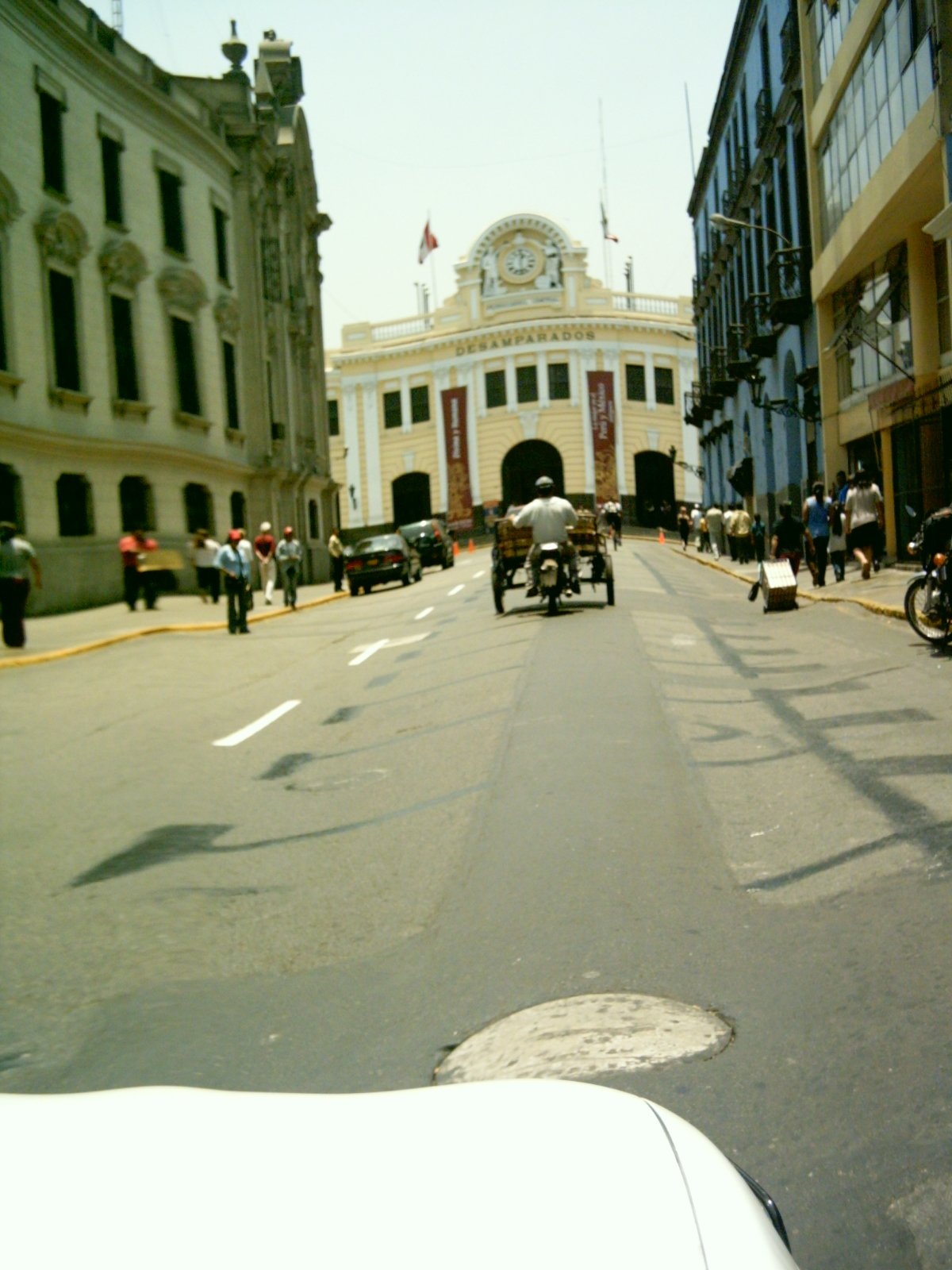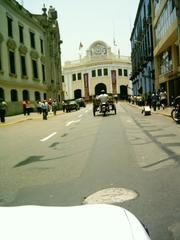
Government Palace Lima, Peru: Visiting Hours, Tickets, and Historical Sites Guide
Date: 14/06/2025
Introduction
The Government Palace of Lima, also known as the Palacio de Gobierno or Casa de Pizarro, stands as a monumental emblem of Peru’s rich history, political power, and cultural heritage. Set on the north side of Lima’s Plaza Mayor, this iconic landmark serves as the official residence of the President of Peru and is integral to the nation’s historical and contemporary identity. Its story stretches from pre-Columbian times—when it was a sacred site ruled by indigenous leaders—through the Spanish conquest, colonial era, and the foundation of the Peruvian republic. Today, the palace invites visitors to experience its layered past, grand architecture, and vibrant public ceremonies. This guide details its fascinating history, visitor information, how to attend guided tours, practical travel tips, and the best ways to experience Lima’s historic heart (Wikipedia; Inca Trail Machu; Thrillophilia; Astelus; MyPeruGuide; Auri Peru).
Table of Contents
- Introduction
- Early Foundations and Pre-Colonial Significance
- The Colonial Era: Foundation, Turbulence, and Transformation
- Viceregal and Republican Periods
- Architectural Evolution and Interior Highlights
- Visiting the Government Palace: Hours, Tickets, and Tours
- The Changing of the Guard Ceremony
- Nearby Attractions and Travel Tips
- Preservation, Access, and Visitor Experience
- Frequently Asked Questions (FAQ)
- Summary and Recommendations
- References
Early Foundations and Pre-Colonial Significance
Long before Spanish colonization, the site of the Government Palace was home to the indigenous ruler Taulichusco and was revered as a huaca—a sacred space in the pre-Columbian world (Wikipedia). This area was not only a center of power for local communities but also a spiritual hub, a fact that made its selection for Pizarro’s residence both pragmatic and deeply symbolic, marking the imposition of Spanish authority over indigenous traditions.
The Colonial Era: Foundation, Turbulence, and Transformation
Foundation and Early Construction
On January 18, 1535, Francisco Pizarro founded Lima and began constructing his palace on this significant site, establishing it as both his personal residence and the administrative heart of the new colony (Inca Trail Machu). The original structure featured adobe walls, spacious patios, and facilities for troops and stables—reflecting a blend of Castilian and local influences.
Turbulence and Transformation
The palace’s history was soon marred by violence; Pizarro was assassinated here in 1541 during a political coup. Afterwards, the property passed through various hands—eventually becoming the official residence of the viceroys of Peru. Over time, the palace was expanded and adapted to the needs of colonial administration, further cementing its central role in regional governance (Tierras Vivas).
Viceregal and Republican Periods
Seat of Colonial Power
Throughout the colonial era, the palace—known as Casa de Pizarro—served as the residence and office of the viceroys. It hosted visiting dignitaries and witnessed decisions that shaped the continent’s fate, including the presence of liberator Simón Bolívar (Inca Trail Machu).
Symbol of the Republic
After Peru’s declaration of independence in 1821, the palace transitioned from a symbol of colonial authority to the seat of the new republic’s executive branch. It became the official residence of the President of Peru, hosting state ceremonies, diplomatic receptions, and many of the nation’s most significant political moments (Wikipedia; Thrillophilia).
Architectural Evolution and Interior Highlights
Fires, Reconstructions, and Modernization
The palace’s appearance reflects centuries of adaptation. After suffering major fires—most notably in 1926—the building was extensively reconstructed. The current structure, completed in 1938, was designed by Polish architect Ricardo de Jaxa Malachowski, featuring a harmonious blend of Neo-Baroque and Neo-Colonial elements. The imposing main façade, with its ornate balconies and intricate stonework, faces Plaza Mayor (Wikipedia; Tierras Vivas).
Notable Interior Spaces
- Hall of Peace (Gran Comedor): A baroque masterpiece with Peru’s largest crystal chandelier, historically used for diplomatic events.
- Golden Hall: Inspired by Versailles, this space is reserved for the most prestigious state ceremonies.
- Sevillian Patio: Adorned with tiles from Seville, connecting the palace to its Spanish heritage.
- Túpac Amaru Room: Named after the indigenous leader and showcasing a blend of Andean and European artistic motifs.
- Residential Quarters: Period-furnished rooms reflecting the palace’s dual function as residence and seat of power.
Visiting the Government Palace: Hours, Tickets, and Tours
Visiting Hours
- Guided Tours: Offered on select days, generally between 9:00 AM and 1:00 PM. Schedules can change due to official ceremonies or holidays; always check the official website or contact the palace in advance (Auri Peru).
- Public Access: The palace’s exterior and Plaza Mayor are open daily for public viewing.
Tickets and Entry
- Cost: Tours are free, but advance booking is required through the official government website.
- Requirements: Valid photo identification (such as a passport) is necessary for entry. Security screening is mandatory.
Guided Tours
Tours (available in Spanish and sometimes English) include key ceremonial halls and patios, with access varying depending on security protocols. Due to limited capacity, advance reservations are essential (MyPeruGuide).
Accessibility
The palace offers some accommodations for visitors with disabilities, but certain historic features may limit full access. Notify the administration of any specific needs before visiting.
The Changing of the Guard Ceremony
A highlight for many visitors, the Changing of the Guard takes place daily at noon in front of the main gates. The Presidential Guard, in striking uniforms, performs a formal handover accompanied by a military band. Arrive early for the best viewing spots, especially on weekends or public holidays (Auri Peru).
Nearby Attractions and Travel Tips
- Lima Cathedral: Directly across the plaza, houses Pizarro’s tomb.
- Archbishop’s Palace: Renowned for its ornate wooden balconies.
- Municipal Palace and Museo del Banco Central de Reserva: Each offers unique insights into Lima’s colonial and economic history.
- Aliaga House: The oldest continuously inhabited house in the Americas, just a short walk away.
Getting There:
The palace is easily accessible from major neighborhoods via taxi or the Metropolitano bus system (“Jirón de la Unión” stop). Allocate extra travel time for traffic, especially during rush hour.
Safety and Security:
Follow all instructions from police and guards. Keep valuables secure and watch for pickpockets, especially during crowded events (Travel.State.Gov).
Dress and Weather:
There is no strict dress code for viewing the palace exterior or attending the guard ceremony, but respectful attire is advised. Lima’s climate is mild but humid; a light jacket and sturdy shoes are recommended.
Preservation, Access, and Visitor Experience
The Government Palace is protected under Peruvian law as a historic monument and undergoes regular restoration to maintain its integrity (Tierras Vivas). Public access is carefully managed to balance security with cultural education. For those unable to join a physical tour, virtual visits are increasingly available (MyPeruGuide).
Frequently Asked Questions (FAQ)
Q: What are the Government Palace visiting hours?
A: Guided tours are typically offered on select mornings (e.g., Tuesday to Sunday, 9:00 AM–1:00 PM), but hours may vary. Check official sources before your visit.
Q: Do I need tickets to enter?
A: Yes, advance booking is required for tours. Entry is free.
Q: Is photography allowed?
A: Photography is permitted for the palace exterior and ceremonies but generally not allowed inside.
Q: Is the Changing of the Guard open to the public?
A: Yes, the ceremony takes place daily at noon and is free to view from outside.
Q: Is the palace accessible for wheelchair users?
A: The plaza is generally accessible, but some palace areas may be challenging.
Summary and Recommendations
The Government Palace of Lima is a living testament to Peru’s multifaceted history, from its indigenous roots to its role as the seat of modern republican power. Its grand architecture, ceremonial traditions, and central location in Plaza Mayor make it a must-see for history enthusiasts and cultural travelers. Plan ahead by booking guided tours, respecting security measures, and combining your visit with nearby attractions to fully experience Lima’s historic center. Stay informed about the latest updates and events by downloading the Audiala app and consulting official resources (Thrillophilia; Wikipedia; MyPeruGuide; Auri Peru).
References
- Wikipedia
- Inca Trail Machu
- Thrillophilia
- Astelus
- MyPeruGuide
- Auri Peru
- Tierras Vivas
- Travel.State.Gov
- UK Government
















































































































